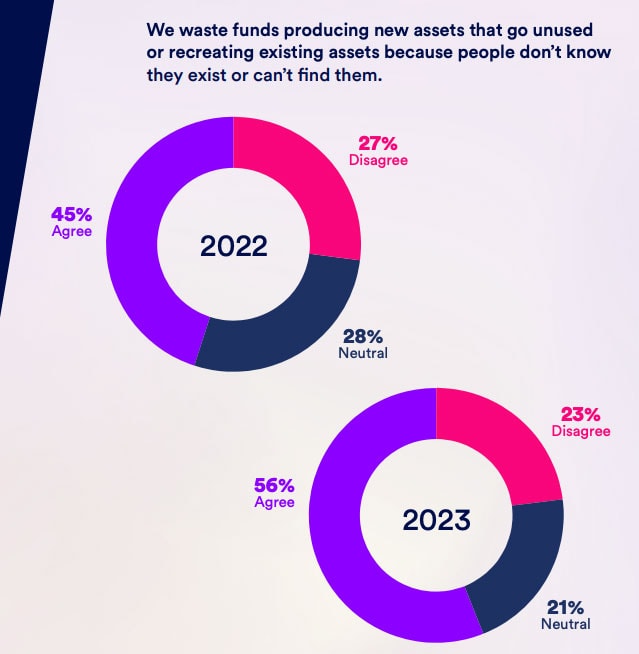10 Benefits of Brand Asset Management Software for Marketing Agencies
Brand asset management software streamlines the organization, retrieval, and use of a marketing agency's and its client's brand assets. These assets include digital files such as logos, images, videos, and other guidelines that embody the brand's identity.
A digital asset management solution provides easy access to the most up-to-date and approved versions of these assets, enabling consistency across all marketing channels.
If you're a marketing agency dealing with multiple brands (each with unique assets), you need to make brand management software your best friend. It simplifies managing vast amounts of digital content, saving time and reducing errors.
What could your marketing team do with an extra seven hours per week?
A study of 10,000 marketers found they spend almost seven hours weekly recreating work. This is an astonishing 4.5 hours higher than the global average.
That's equivalent to an extra working day.
From the same report, marketers felt:
- They only spent 28% of their time doing what they were hired to do.
- 60% of their time was wasted on unnecessary tasks like searching emails for information.
And 90% of marketing teams feel they're not as effective as they could be because they don't have the right processes in place.
Locating digital assets is an unnecessary time drain
Finding digital assets and documents is a pain for nearly every department.
However, for marketing departments and agencies, not having quick access to the latest version of an asset stalls campaigns and produces erroneous work. Of course, this is the last thing you need when you're trying to impress and keep clients in an already competitive industry.
And a large portion of marketers are feeling the pain.
The State of Digital Asset Management 2023 report tells us how:
- 60% of study participants report catching team members using the wrong version of a logo
- 56% of marketing teams believe they waste money on asset creation because people can't find them.
- 51% of teams waste time searching for digital assets.

Such issues are beneath your marketing agency. You've carefully assembled your talented team to produce breathtaking campaigns, not spend their time searching for a logo.
Unfortunately, the most creative individuals can't flex their muscles without the tools to succeed. A report explains how 70% of marketing decision-makers agree that their department is a bottleneck to delivering optimal customer service.
Investing in brand management software does make a difference. The same report states that 28% of marketers who use it now spend less time searching for assets, with 35% wasting less time managing assets.
10 Benefits of Brand Asset Management Software for Marketing Agencies
Managing all your clients' assets in one place is logical to a sound mind. Brand management software enables this. Let's explore the ten benefits of investing in this valuable marketing tool.
1. A centralized asset repository
Picture this:
The marketing manager has the agency's updated logo, while the sales team keeps attaching the old logo to client proposals. Face-palm.
Or the team is trying to make a light-colored version of a client's logo visible on a piece of marketing material — not realizing there is a darker alternative.
With no centralized location, assets are scattered across different team members' computers, cloud storage accounts, and external hard drives. The result? Version control issues or difficulty locating an asset.
And let's face it. This is no way to work efficiently.

Centralized storage offers a single source of truth for all digital assets and serves as quality control in preserving the integrity of digital assets throughout their lifecycle.
Organizing your image library and other assets ensures every team member accesses the same repository, always using the most current and approved asset versions. This organization helps teams roll out high-quality campaigns quickly without being burdened by an unnecessary bottleneck.
2. Easy and quick retrieval of assets from anywhere
Imagine accessing the latest version of client brand materials from any corner of the world.
Beyond having your assets in one place, it's about reaching them anytime, anywhere. That makes the software an absolute boon for teams increasingly embracing remote work or spreading across different locations.
In the past, finding an asset might have felt like searching for a needle in a haystack. But with advanced search and filtering options, it's more like having a digital magnet to draw out exactly what you need at the moment.
Need the latest version of a logo? Type in the name, apply a filter, and bam — there it is. Quick retrieval isn't just a fancy feature — it's a critical time-saver that lets marketers spend more time creating and less time hunting for assets.

Whether accessing your entire asset library while sipping coffee in a Parisian café or quickly finding the exact image you need to nail your next client presentation, easy accessibility transforms how marketing agencies operate, fostering efficiency and connectivity from anywhere.
3. Efficient organization of brand assets
Design team hands up if this scenario looks familiar:

Navigating through an extensive content library becomes significantly smoother with efficient organization in a brand asset management system.
Structured categorization steps in to bring order, employing tags, folders, and metadata to systematically arrange every asset. It's akin to creating a tailored roadmap, guiding users to what they need without unnecessary detours.
For instance, assets vital for a particular marketing campaign are readily accessible, and those cleared for social media use are neatly segregated.
Version control plays a pivotal role in ensuring accuracy and consistency. It's the safeguard against the inadvertent use of outdated or unapproved content. With version control, the latest logo version is always at the team's fingertips, preventing potential mishaps and ensuring every output aligns with the brand's current standards.
Thankfully, brand asset management software is a user-friendly hub that streamlines workflow to help talented creative teams become more focused and productive.
4. Enhanced collaboration
Simultaneous access to the latest digital assets is a game-changer. It enables multiple team members to work on assets together, regardless of their physical location.
It's like having a collaborative canvas where everyone can contribute, edit, and refine without waiting in line. This speeds up project timelines, streamlines the approval process, and ensures that ideas and changes are captured in real-time.
Clear communication is the essence of any successful team. Brand asset management software becomes a space for dialogue, where team members can leave comments, provide feedback, and make suggestions directly on the assets.
This transparency removes the need for back-and-forth emails or the need to "jump on a quick call." That way, every voice is heard, leading to more informed decisions and stronger results.

5. Brand consistency
The sum of everything we've discussed so far leads to brand consistency.
Brand asset management software ensures the color palette, typography, or logo usage gets checked and aligned, leaving no room for discrepancies and ensuring you always produce quality content.
Imagine a world where every piece of marketing content, every advertisement, and every social media post echoes the brand's identity with unwavering consistency. That's the level of uniformity we're talking about.

The software acts as a guardian, ensuring that the brand's story remains coherent, whether it's being told on a billboard, in an email campaign, or on a social media platform.
You don't need us to tell you how this strengthens your and your client's brand's presence in the market and builds trust with the audience, as they receive a consistent brand experience wherever they interact with the brand.
6. Scalability
Imagine you're getting an influx of clients. You want to start the onboarding process and have everything you need to start producing campaigns quickly.
Brand asset management software doesn't just meet today's needs but grows and evolves with the agency.
As the team expands and the asset library bulges, the software adapts seamlessly, ensuring that the transition from small-scale operations to larger, more complex projects happens without a hitch.
Future-proofing is another critical aspect of scalability. The marketing world is in constant flux, with industry trends and technological advancements shaping and reshaping the landscape.
A scalable brand asset management system stays ahead of the curve, continuously updating and innovating to meet these changes head-on. It's not just about surviving in a competitive industry. It's about thriving, embracing change, and using it to propel your agency forward.
7. Analytics and reporting
Brand asset management software provides invaluable insights into how assets perform and how teams employ them, transforming raw data into a goldmine of information.
You can make informed decisions beyond gut feelings or assumptions with these insights. It's about having a clear, evidence-based view of which assets resonate the most, which ones might need a revamp, and how to allocate resources more efficiently. Every choice becomes data-driven, rooted in real-world asset performance.
Let's say you are working on a nationwide campaign. The analytics tool within your brand's asset management software could reveal that while urban-themed images perform exceptionally well and engage the audience, rural-themed images aren't garnering the same attention.
This insight enables the agency to make informed, strategic decisions about content creation and asset allocation for future campaigns.
8. Better legal and compliance assurance
The software diligently manages and tracks licenses and copyrights, ensuring that all visual and textual content is used per legal agreements.
For example, if your agency has purchased stock images for a specific campaign, the software keeps track of the usage rights. Then, it can alert the team if they are near exceeding the licensed number of uses or if the license period is about to expire.
All marketers are familiar with the painstakingly humorous 'approval from legal' memes. By connecting legal teams to the software, you can get things approved quicker and put those nightmarish delays in approval to bed.
9. Security of assets
With cyber threats prevalent, the importance of secure asset storage and management can't be overstated.
The software provides robust encryption and secure access controls, ensuring only authorized personnel can access and modify the assets.

The software also ensures the secure sharing of assets, which is especially crucial when offering your client a digital asset management platform.
Instead of relying on less secure file transfer methods, agencies can confidently share assets through the software, knowing that their digital properties are safeguarded during the entire process.
10. Build client trust
Earning a client's trust is priceless. Not only do you retain their business, they're likely to get you more.

A high level of professionalism is visible when agencies use consistent and timely assets, ensuring that every piece of content aligns with the client's brand guidelines.
For instance, the agency can swiftly access the most current version of logos and branding elements when presenting campaign materials. This action demonstrates meticulous attention to detail and a deep understanding of the client's brand identity.
Client confidence grows when they see their brand represented accurately and cohesively across various channels. The software ensures that every banner, brochure, and social media post reflects the brand's core values and visual identity, fortifying the brand's presence in the market.
This consistency enhances the brand's reputation and builds a foundation of trust between the client and the agency.
Build a healthier bottom line with brand asset management software
Choosing the best brand asset management software translates into substantial cost and time savings, directly impacting your bottom line in a good way.
Consider a scenario where you're handling multiple campaigns simultaneously. Without a centralized asset repository, employees might spend hours each week locating the right versions of their creative assets.
The key benefits of digital asset management systems are these assets become readily available in their most up-to-date form — cutting down retrieval time drastically and enhancing overall productivity.
The software minimizes the need for additional storage solutions and reduces legal and security risks.
Using digital asset management software benefits your brand by contributing to a leaner, more agile operation. It positions your agency to deliver exceptional value to your clients while bolstering your financial health and competitiveness in the market.

Joanne Camarce
Share this Post

